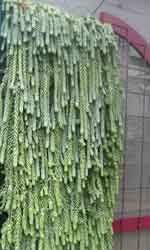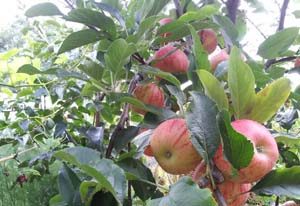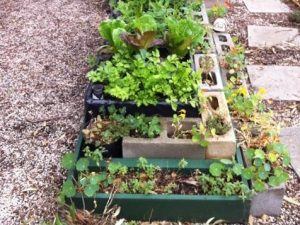Are you wondering what gardeners can do about climate change? Gardening and agriculture produce several greenhouse gasses apart from carbon dioxide – and we can help lower emissions of most of them. Even if each gardener can only decrease small amounts of them, every bit counts!
Scientists have been warning about the warming climate for the last 30 or more years, but it has taken a long time for governments to recognize that it is occurring. Those of us who are close to our gardens and the land have seen the effects already happening such as fruit ripening earlier or not at all because there was not enough winter chill.
In Australia both the CSIRO1and the Bureau of Meteorology2 have issued reports in 2020 showing that temperatures have increased by 1.4 degrees Celsius since 1910 with most warming occurring since the 1950s. They also describe what we are expecting in the future, including increases in dangerous fire weather days, ocean warming and acidification, less snow and more changes in rainfall patterns with increasing intense events.
While we must adapt to the coming changes, we need to be taking action NOW to try to slow the rate of global warming that is causing these changes. Gardeners can help!
Increase Vegetation Cover
We all know that Landcare groups have been planting trees for many years to prevent erosion on degraded land. Fortunately, these plantings also help take up carbon dioxide from the atmosphere – as long as they become permanent carbon sinks. However, the rate and amount of greenhouse gas removal by trees is not as high as the emissions from use of fossil fuels, so very large areas of land need to be devoted to forests3.
 Gardeners can help by planting as much vegetation as possible – even lawn helps! However, if you live in a bush fire prone area take care with the location and type of trees or shrubs.
Gardeners can help by planting as much vegetation as possible – even lawn helps! However, if you live in a bush fire prone area take care with the location and type of trees or shrubs.
Reducing carbon emissions can also be achieved by avoiding concrete in paving and walls since it creates high greenhouse gas emissions in its manufacture. And don’t forget green walls and roofs! Not only do they add more plant cover, but they add insulation to buildings, so reducing energy use in heating and cooling.
But although these actions are important, there is much more that gardeners can do!
Reduce Use of Fertilisers
It is being increasingly realized that nitrous oxide produced when nitrogenous fertilisers break down in the soil makes a significant contribution to global warming – nitrous oxide is around 300 times more powerful than carbon dioxide as a warming gas and around 10 times more powerful than methane.
Of course, the bulk of such fertilisers are applied as synthetic products and manures in agriculture to cropland and pasture and nitrous oxide is also produced from the chemical industry, wastewater treatment and fossil fuel burning. But gardening uses them too.
We can reduce the polluting effect of these fertilisers by:
- matching levels of application to the actual needs of plants,
- applying them in slow release form
- rotating leguminous crops, which produce their own nitrogen, with other crops.
- using as many natural growing methods to improve productivity by improving enhance soil quality.
Although compost or worm castings/ tea from your own green/food waste are not rich in nitrogen, they have the benefit of not requiring fossil fuel use and, therefore, having relatively low carbon emissions.
Manures from your chooks or collected from farms will still cause nitrous oxide emissions but they cause less release of carbon dioxide than commercially sourced manures which produce carbon emissions through their transportation. Other organic products such as blood and bone, fish meal, seaweed extract, compost and natural minerals e.g. organically certified phosphorus are less energy-intensive than chemical fertilisers that have gone through complex extraction and manufacturing processes.
Composting
Sending organic waste to landfill results in methane production because decomposition occurs in the absence of oxygen. In contrast, composting it, either at home or commercially, reduces methane production and, although aerobic composting in your compost heap produces some carbon dioxide, application of the finished product to soil helps soil to retain carbon as well as increasing its fertility.
Biochar
Biochar is charcoal derived from the burning of plant material in the absence of oxygen. This creates a stable form of carbon rather than releasing carbon dioxide to the air by natural decay processes. It has become slowly more popular over this century for that property and also its capacity to benefit plant growth. When added to soil it improves its structure, helps retain water and provides a surface for beneficial soil microbes and fungi which help plants take up nutrients. It also creates a stable form A number of years ago, SGA published an article reviewing biochar and indicating how gardeners can make their own. Now it is produced by several commercial companies and is sold by a range of garden centres and other retailers.
Pest Control
Using integrated pest management techniques and companion planting rather than manufactured products to control insects, weeds and disease also reduces carbon emissions. These alternative approaches minimize the need for such products which require energy-intensive, carbon-dioxide emitting processes in their production and transportation.
Modify Our Diets
Many people are now realizing that we can reduce the rate of global warming by consuming less meat and dairy products4. Eliminating  meat from the diet reduces greenhouse gas emissions by approximately 50% because there are fewer methane-producing animals required to produce food 5. In contrast, fruit and vegetable production draws down carbon dioxide through photosynthesis. So even just reducing the number of times you eat meat per week will make a difference. On top of this, to provide the same amount of nutritious food, meat production uses up more land as pasture than growing fruit and vegetables. So when gardeners grow fruit and vegetables at home or in a community garden or replace beef, lamb and pork consumption with eggs from their own chooks, they are making a contribution to slowing climate change,
meat from the diet reduces greenhouse gas emissions by approximately 50% because there are fewer methane-producing animals required to produce food 5. In contrast, fruit and vegetable production draws down carbon dioxide through photosynthesis. So even just reducing the number of times you eat meat per week will make a difference. On top of this, to provide the same amount of nutritious food, meat production uses up more land as pasture than growing fruit and vegetables. So when gardeners grow fruit and vegetables at home or in a community garden or replace beef, lamb and pork consumption with eggs from their own chooks, they are making a contribution to slowing climate change,
If you are taking those actions already, you also know about the added health benefits. More plant-rich diets address many of the increasingly frequent health issues including heart and circulatory problems 6, some forms of cancer 7 and even rheumatoid arthritis8 by reducing dependence on red meat.
Reduce Shopping Miles
Grow Your Own
If you grow your own fruit and vegetables, even just a few on a balcony or courtyard, you are reducing food miles (a measure of carbon-based fuel used to get food to you) as well as making the contributions to reducing carbon emissions described above.
But there is a lot more we can do regarding our levels of consumption.
Buy Locally
We are hardly ever totally self-sufficient for food and still purchase items which may have travelled many miles to reach us, using fossil fuels in the process. So let’s try reducing food miles by buying what we can’t grow ourselves from local growers when we cannot produce it ourselves – think Farmer’s Markets, Harvest Swaps and foraging for food.
We can seek out other items for the garden e.g. furniture, stakes or pots, which are produced in Australia – or even better in our own state – rather than those that are imported. This may mean a higher financial cost, but that may encourage us to either make our own or reduce our overall material consumption.
Reduce, Reuse, Recycle
We can become thrifty gardeners!
Being clever about minimizing our purchases, reusing items and recycling what we can’t reuse in their current form means less waste, less resource use (including less coal-fired electricity) and less waste going to landfill which would lead to methane production.

For example, we can minimize use of plastic pots for seedlings by making containers using the centres of toilet rolls as the sides and some newspaper in the bottom. In fact, newspaper can be used to make complete seedling pots. Both alternative types of “pot” are also better for seedlings since the whole “pot” plus seedling can be popped directly into a garden bed without disturbing the roots – the cardboard or paper will gradually decay.
Some clever ideas for reusing and recycling in the garden have been used in the garden of one of SGA’s subscribers. Recycled materials can be used for garden edging and garden art.
So we can be creative, enjoy our gardens, build our local communities and be healthier, more comfortable and save money at the same time as helping alleviate the rate of global warming.
References
-
https://www.csiro.au/en/Showcase/state-of-the-climate
-
www.bom.gov.au/state-of-the-climate/
-
Baldocchi D, Penuelas J. (2018). The physics and ecology of mining carbon dioxide from the atmosphere by ecosystems. Climate Change Biology https://doi.org/10.1111/gcb.14559
-
Hedenus F, Wirsenius S, Johansson DJA (2014) The importance of reduced meat and dairy consumption for meeting stringent climate change targets. Climatic Change. 124 (1–2): 79–91.
-
Hoolohan C Berners-Lee CM, McKinstry-West J, Hewitt CN. (2013) Mitigating the greenhouse gas emissions embodied in food through realistic consumer choices. Energy Policy 63: 1065-1074.
-
McEvoy CT, Temple N, Woodside JV (2012) Vegetarian diets, low-meat diets and health: a review. Public Health Nutrition 15 (12): 2287-2294.
-
Prashanth Rawla, Tagore Sunkara, Adam Barsouk (2019) Epidemiology of colorectal cancer: incidence, mortality, survival, and risk factors.
-
Philippou E and Nikiphorou E. (2018) Are we really what we eat? Nutrition and its role in the onset of rheumatoid arthritis. Autoimmunity Reviews 17(11): 1074-1077
Related Articles:
Mastering Essential Winter Gardening Skills
As the cold of winter sweep across the landscape, many gardeners in the South of Australia retreat indoors, awaiting the warmth of spring to resume…
Companion Planting
Heard about companion planting but don’t know what it is or where to start? This video explores how to use companion plants to improve the health…
Strawberries
I adore strawberries (Fragaria sp.), and one of my earliest memories is a birthday cake absolutely heaving under the weight of a sack full of home…
Climate Resilient Gardening
Introduction Gardeners in Australia are facing a race against time as they experience the growing impact of climate change in their own gardens. The…




